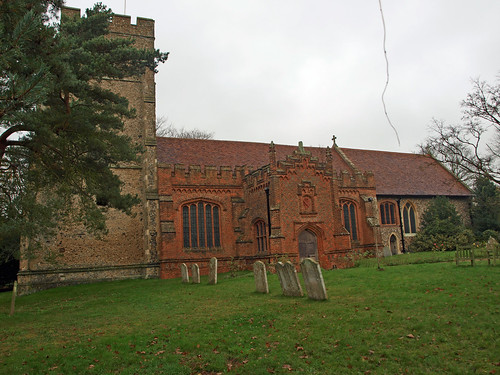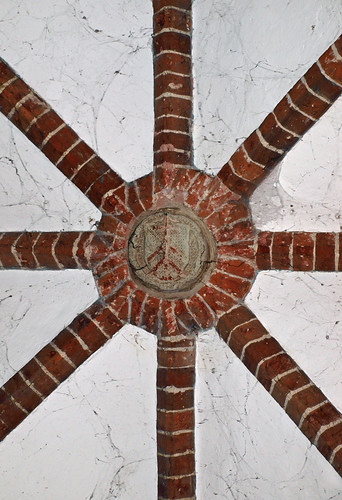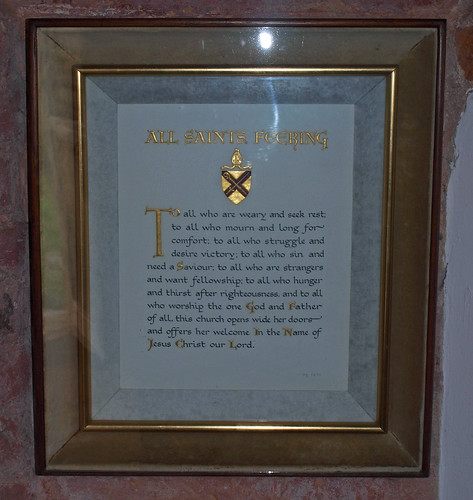I've revisited several times now and keyholder numbers are now listed but they've both been out when I've called.
ALL SAINTS. In a pleasant village setting. All Perp. C14 N aisle, and chancel, C15 W tower, early C16 nave and S porch. The latter are of brick and the most interesting feature of the church. Three- to five- light windows, a little brick and flint decoration, battlements on trefoiled corbel friezes. Stepped battlements on the porch. Star-like tierceron vault in the porch (cf. Great Coggeshall). Chancel and N aisle windows simply Dec. N arcade on square piers with four demi-shafts (cf. Witham), arch with two quadrant mouldings. - STAINED GLASS. Original C14 tabernacles in situ in a N window. - MONUMENT. Recess in the N wall, shafted and with ogee head.
FEERING. One of its houses, Feering Bury, has seen some famous figures under its roof. Here Queen Elizabeth came to stay; here came Bishop Bonner who sent the Protestant martyrs to their doom; and here came Bishop Ridley, the martyr to whom Latimer spoke that brave farewell which rings down the ages still. Still in the windows are Tudor arms, and there are two chimneys of the 17th century. In the village is an inn old enough to have been seen by all these people; and Houchin’s Farm, with two storeys over-hanging on brackets of grotesque figures, and a moat filled with water.
The fine brickwork of the Tudor builders gives the church a glow of warmth between the solid grey of the 14th century chancel and the 15th century tower. Parts of the nave are 700 years old, but the south wall has been refashioned in brick. There is a splendid porch with pinnacles, battlements, much ornament, and a vaulted roof, all medieval, as is the door with its fine ironwork. A 13th century coffin lid with a fine cross is the oldest treasure inside the church. There are scraps of old glass, some 600 years old and one with Queen Elizabeth’s initials; one medieval chest and another of about 1600; and a canopied recess which is either the tomb of a benefactor or an Easter Sepulchre unusually placed in an aisle. The finest woodwork is on the pulpit, which has vigorous carvings probably by Flemish artists of 300 years ago. We see the Scourging of Our Lord, His drooping figure under the weight of the Cross, and the mocking of the Roman soldiers.
Simon K -
Kelvedon & Feering is a joint village, a large one, larger than
some towns, but undoubtedly a village in character. The continuous
High Street of both is the old A12, which bypassed it as a dual
carriageway to the east in the 1960s, but it still seemed pretty busy
to me. The two parts are historically separated by the infant River
Blackwater, although more practically separated by the Norwich to
London railway line which runs alongside it. This makes it sound
hellish, but actually it is very pleasant, with some good late
Medieval and Georgian domestic buildings.
Open. I noticed that the church now displays a large and welcoming keyholder notice in the porch.
This is a handsome church, very much in the west Suffolk style with a wide nave and castellated walls, but with a beautifully mannered red brick south aisle which reminded me of Kenton in East Suffolk. It is difficult to believe that, as recently as 20 years ago, Feering was a star in the Anglo-catholic firmament, largely thanks to the incumbency of a traditionalist Rector who had been there for many years. I had not heard its name mentioned in such circles in recent years, and so it was no surprise to find a place which I immediately thought was really in danger. For the first time today (it would happen once more) I felt the sense of a church slipping away from us. The keyholder was magnificent. She was elderly, but her frailty was mixed with a great intelligence. I ended up staying here almost an hour, mostly chatting with her. She had lived the Anglo-catholic movement since her childhood in the 1930s. She knew she was in its last days, and told me that she had no wish greater than to become an anchorite!
The church was by no means as interesting as she was, but it was still much more interesting than Kelvedon - not difficult. The star here is the range of English and continental medieval glass collected and placed here during the incumbency of the aforementioned rector. There is half a medieval sculpture of St Anne, a rare survival. There is also a photographic copy of the Constable 'Raising of Lazarus' altar piece which is at Dedham. I recognised it instantly, having been there two weeks ago. The painting had originally been in Manningtree church - Constable also did altar pieces for Nayland and Brantham churches. When Manningtree church closed in the 1960s, the Rector of Feering offered to buy it, and was offered it for the princely sum of £150! For thirty years, it was displayed in Feering parish church. The Rector bequeathed it to the parish in his will, and then in the late 1990s it was sold to raise money for the restoration of the church. It is now on permanent display at Dedham.
I was glad to see Feering church inside, because I am sure it will be declared redundant in the next ten years. I left the village to the north, and soon gained open if somewhat hilly countryside.
Flickr set.




No comments:
Post a Comment